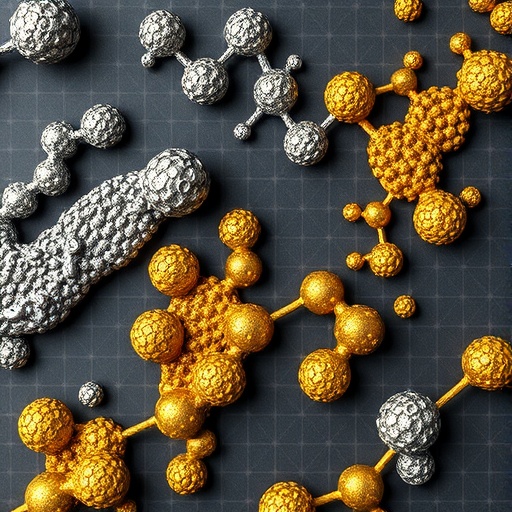In a groundbreaking study, researchers have introduced a novel approach to enhance photoelectrochemical water splitting by utilizing Cu nanoparticles on vacancy-rich TiO2. This innovative combination leverages the unique properties of both materials to improve efficiency, which has significant implications for sustainable hydrogen production and renewable energy generation. The rise of renewable energy sources has made water splitting—a process that converts water into hydrogen and oxygen using sunlight—an increasingly vital field of research.
Traditionally, TiO2 has been a go-to semiconductor in photocatalytic applications due to its stability, non-toxicity, and ability to harness ultraviolet light. However, its performance in visible-light absorption and overall photocatalytic activity has been limited, prompting decades of research to overcome these challenges. The introduction of Cu nanoparticles to modify TiO2 may represent a turning point, bridging the gap between theoretical potential and practical application.
The premise of this research centers around vacancy-rich TiO2, which contains structural inconsistencies that can serve as active sites for chemical reactions. These vacancies facilitate electron transfer processes, enhancing the photochemical properties of TiO2. However, vacancy-rich structures are often unstable, which leads to concerns regarding the durability of such materials in practical applications. The researchers sought to tackle this issue by strategically decorating these vacancies with Cu nanoparticles, thus stabilizing the structure and simultaneously boosting its photocatalytic activity.
The synergy between Cu nanoparticles and vacancy-rich TiO2 can be attributed to several factors. First, the introduction of Cu enhances light absorption across a broader wavelength spectrum, enabling the system to effectively harness more sunlight for water splitting reactions. Simultaneously, Cu nanoparticles can lead to improved charge separation, minimizing electron-hole recombination—a common challenge that diminishes the efficiency of photocatalytic processes.
Experimental results detailed in the study reveal that Cu-decorated vacancy-rich TiO2 exhibits a remarkable increase in hydrogen production rates compared to pure TiO2 and even other conventional photocatalysts. This finding underscores the potential of incorporating metal nanoparticles to significantly enhance the photocatalytic performance of TiO2 under solar irradiation. The implications are far-reaching, signaling potential advancements in clean energy technologies that rely on efficient hydrogen production.
Moreover, the researchers conducted thorough characterizations of the synthesized materials using techniques such as X-ray diffraction (XRD), scanning electron microscopy (SEM), and transmission electron microscopy (TEM). These analyses revealed insights into the morphology, size distribution, and crystallinity of the Cu nanoparticles, as well as their interaction with the TiO2 matrix. This meticulous characterization not only confirms the successful integration of Cu nanoparticles but also sets a standard for future studies aiming to design improved photocatalysts.
In addition to improving the photocatalytic efficiency, the integration of Cu nanoparticles also influences the stability and longevity of the TiO2 system. Enhanced structural integrity means that these materials can withstand prolonged exposure to operational conditions without significant degradation, an essential quality for any practical application in renewable energy systems. The stability of a photocatalyst is often a limiting factor for its commercialization, and this research addresses that concern directly.
Furthermore, the exploration of Cu as a dopant brings forth its economic advantages over precious metals traditionally employed in photocatalyst designs. By using copper, a more abundant and cost-effective material, researchers are not only enhancing performance but also paving the way for the large-scale adoption of water-splitting technology. The cost-effectiveness of these materials will be crucial for their integration into future hydrogen production systems and energy infrastructures.
The implications of this research extend beyond hydrogen production. The advancements in photocatalytic materials may also facilitate other applications, such as air purification, carbon dioxide reduction, and water treatment. The versatility of TiO2 as a semiconductor means that modifications leading to increased efficiency can significantly impact diverse environmental applications. Enhanced photocatalysts with improved efficiencies may contribute to global efforts aimed at reducing greenhouse gas emissions and combating climate change.
Additionally, the collaboration between various fields such as materials science, nanotechnology, and chemistry underscores the interdisciplinary nature of this research. Future work could focus on fine-tuning the ratio of Cu to TiO2, optimizing the experimental conditions for maximum yield, and even exploring alternative metal nanoparticles. The findings pave the way for future advancements in photocatalytic material research, marking a significant step forward in the quest for sustainable energy solutions.
Researchers predict that continued exploration in this area will yield even more innovative materials with enhanced performance metrics. As the demand for clean energy increases, the role of such advancements in photocatalyst design will be critical in meeting energy needs sustainably. The ongoing pursuit of alternative energy solutions, combined with the ability to leverage abundant materials like copper, may lead to transformative technologies that redefine energy generation.
In conclusion, the integration of Cu nanoparticles with vacancy-rich TiO2 marks a significant advancement in the field of photoelectrochemical water splitting. The increased efficiency, stability, and cost-effectiveness of the developed materials underscore the potential for sizable contributions to sustainable hydrogen production. Researchers remain optimistic that this development will inspire further innovations within the realm of photocatalysis and renewable energy technologies.
Through this research, the scientific community is not just moving towards enhanced water-splitting techniques, but also fostering a greater understanding of how to efficiently utilize and manipulate semiconductor materials for groundbreaking applications. The implications of these findings herald a new era in energy technology that can potentially transform the landscape of renewable energy. As the journey continues, the research team’s commitment to innovation could set a benchmark for future investigations aimed at creating highly efficient, eco-friendly solutions to our planet’s energy challenges.
Subject of Research: Photoelectrochemical water splitting using Cu nanoparticles on vacancy-rich TiO2.
Article Title: Cu nanoparticles decorated vacancy-rich TiO2 for efficient photoelectrochemical water splitting.
Article References: Huang, Z., Xie, Y., Guo, Y. et al. Cu nanoparticles decorated vacancy-rich TiO2 for efficient photoelectrochemical water splitting. Ionics (2025). https://doi.org/10.1007/s11581-025-06593-7
Image Credits: AI Generated
DOI: https://doi.org/10.1007/s11581-025-06593-7
Keywords: photoelectrochemical, water splitting, Cu nanoparticles, TiO2, renewable energy, hydrogen production, photocatalysis, sustainability, materials science.
Tags: Cu nanoparticlesCu-decorated catalystselectron transfer processes in catalystsinnovative materials for energy conversionphotocatalytic activity improvementphotoelectrochemical water splittingrenewable energy generationstability of photocatalytic materialssustainable hydrogen productionTiO2 semiconductor applicationsvacancy-rich TiO2 structuresvisible-light absorption enhancement





